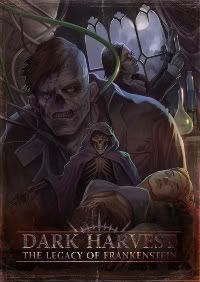Our first non-English language review too (that I know of)!
This comes from the Polish gaming site Poltergeist. Google translate, and the score at the bottom of the review of 8.5/10, tells me that the reviewer Paweł ‘Chimera’ Cybula liked the game. My thanks to both Pawel and Poltergeist, and to the many kind comments under the review. Go have a look here for yourselves.
Addition:
Pawel was kind enough to translate his own review, so here it is!
A Beautiful Nightmare
Dark Harvest: The Legacy of Frankenstein is a Cubicle 7 game set in an alternative Europe at the beginning of the 20th century. A Europe in which Romania had been replaced by the Kingdom of Promethea: a closed state ruled with a rod of iron by the king Victor Frankenstein.
I. Introduction
The book starts with a short description of the setting – a feudal country controlled by an aristocratic and militaristic regime, whose elites indulge in a life of pleasure. Thanks to Frankenstein’s science, this life may be theoretically everlasting.
Next, there is a short story called Como, in which envoys of different countries meet Frankenstein on the Italian lake to witness a miracle and the birth of a new dream. The story is nothing more than typical fluff and its main value lies in the fact that it doesn’t discourage further reading.
II. History
On these pages the events leading to the birth of Promethea are described. The history of the region in the 18th and 19th centuries is presented in such a way that it is difficult for the average reader to notice the fictional bits – obviously, only until the moment of Frankenstein’s revelation and the transformation of Romania into a kingdom, which concluded on June 8th 1902. A nice touch is added by the inclusion of the ingeniously designed national flag of the new state.
III. Promethea Now
This large chapter of twenty six pages gives a detailed overview of the state and its very hierarchical class society.
The most important law shaping Promethea is the one of the Harvest, which allows the aristocracy and some of the high-rank scientists, financiers and officials to use organs transplanted from the dead and living bodies of those from the working class. The transplantation and augmentation technology makes it possible for the privileged to preserve youth and increase their physical attributes. It also launched a new culture, in which surgeons have a status similar to that of famous fashion designers – the decision about a new transplant may be motivated as much by necessity as by the newest trend or a fad.
In this chapter the reader learns about the rules of the Harvest, the most common abuses associated with it and Frankenstein’s ambiguous attitude towards this practice. The Harvest feeds on the lowest class, the workforce, whose members live in admittedly better conditions than their counterparts in other countries, but at the cost of constant fear and omnipresent surveillance by the bureaucratic and militaristic juggernaut that Promethea has become. The regulations allowing the elite to abuse the Harvest were forced upon Frankenstein at the moment of his coming to power and now he is planning to get rid of them and the whole aristocratic old guard, whom he deems corrupt and reactionary.
Dissatisfaction with the present state of affairs has given birth to the Resistance led by Frankenstein’s monster himself. The situation gets more complex with foreign agents and the Promethean Orthodox Church in the picture. However, the monster realizes that most foreign powers would love to lay their hands on the Harvest technology and that the Church will never accept him as a leader or even a human being. By the way, reading about the state-church relations was particularly interesting to me as a citizen of a former communist state, fiercely atheistic.
There is a mention of the Roma population, overwhelmingly pro-Resistance after the Hasdat tragedy – a mass execution of the inhabitants of a village in which partisans had found shelter. All those people were Eviscerated (see below), left for a month and then burnt with the entire village.
A lot of space is devoted to the military, security forces and courts. Promethea’s augmented soldiers, deployed for the first time during the annexation of Transylvania, are the best in the world, the security forces keep a tight grip on the domestic affairs and in most cases only the rich may expect a fair trial. The description of the state is realistic enough to believe in its efficient functioning at the beginning of the 20th century and the numerous atrocities do not seem too improbable knowing what this century had in stock for humanity. One of them is Evisceration – skinning the convict and removing his organs publicly while keeping him alive for as long as it is possible. It is used for only the most serious of crimes, particularly treason.
Except the above mentioned, the chapter contains an overview of the Romanian burial traditions (the Harvest is particularly opposed in the regions where these traditions are the strongest), brief info on the main European powers and a map of Promethea and its frontiers.
All in all, this is excellent material. Rarely do you come across such an original, well-designed and well-presented setting.
IV. Piercing the Veil
Here the reader gets short descriptions of forty one counties in Promethea followed byBucharestand Targu Mures, the present seat of Frankenstein. A comment by an ordinary citizen, a partisan, a civil servant or a military man precedes each of the descriptions. Railroad lines are detailed, as well as Promethea’s ports, which are with no exception fortresses almost completely devoid of civilians since the only craft allowed on the country’s waters are the military ones. The descriptions also include some snippets on the Resistance, industry, the environment and other things characteristic for a given region, which should be of much use to a Gamemaster who wants to vividly present this quite unknown part ofEurope. The final part of the chapter describes the borders of Promethea and typical military and augmentation facilities.
This pretty dry section might prove a bit tedious, but I think it to be indispensable as a source of useful information if you want to get and convey the feel of the setting.
V. Anthology
This is one unusual idea – to put in the middle of a core book a set of five short stories by different authors. The stories are all satisfactory and provide scenes and protagonists that might serve as an inspiration for the Gamemaster. Therefore, Harvest Moon depicts the tragic ending of a harvest festival in a mountain village, Loreley introduces a riverside laboratory discovered by a lone soldier on a steamboat patrol, Opportunity takes you to the not-so-deserted streets of Bucharest by night, Magdja’s Runner centers around a sadistic form of entertainment preferred by a hunt-loving boyar and Witness is a first-hand report of the atrocity committed on the people of Hasdat.
VI. The Roleplaying Game
The title of this section might come as a surprise – so what have you been reading on the previous one hundred and fifteen pages? The authors define their work as part anthology, part sourcebook and a complete roleplaying game at the same time. It clearly seems that the setting material was given priority, which added to its complexity and intensity.
I am not familiar with the Victoriana rules, of which a simplified version is used in this game, but what is here did not strike me as very complicated or extensive. The basics take up four pages plus five more devoted to combat. When your character performs an action, you gather an amount of D6’s equal to the sum of one attribute and one skill. Each 1 or 6 is considered a success and if you roll a 6 you may roll that die again to gather more successes. The number of successes determines the degree of success, from partial to god-like. Depending on the circumstances, the Gamemaster may give some Black Dice to the player who makes a roll. Each success on the Black Dice cancels out one of the successes on the regular dice (6’s do not get re-rolled though). Therefore, one may end up with a negative result, which means a Foul Failure – something really bad happening to your character.
In combat, the character who took the initiative chooses which opponent he attacks. The opponent usually uses his action to defend himself or he becomes a very easy target. The attacker gets two extra dice whereas the defender is also able to cause damage. They act simultaneously – two rolls determine who wounded whom in a given round. Nevertheless, I am quite distrustful of systems in which combat involves dice pools, successes and more than one roll. In Dark Harvest there are three in each round: initiative, attack/defense, damage (no soak roll). I am convinced that it may slow things down, especially with advanced characters capable of dividing their dice pools effectively.
Character creation doesn’t differ much from what you have in most games – you get some character points that can be spent on attributes, skills, talents, augmentations, privileges, assets and contacts. You can also choose up to three complications to get more points. Generally, the whole process is rather simple although it may be time-consuming for players who are just starting their adventure with this game. However, after some time they will probably appreciate a substantial number of options. Beginning characters are not particularly powerful, but competent enough to stand out among the average inhabitants of Promethea.
In this section you also find a list of typical Romanian names as well as rules for automatic successes, Fate Points (can be used to add more successes) and class modifiers (very appropriate in this setting).
What else? Quite a lot:
a) rules for surgeries and possible complications;
b) rules for gaining experience and reputation;
c) more rules for Fate Points and their more powerful version, Scripting Dice;
d) a very modest list of weapons (the authors refer you to Victoriana sourcebooks);
e) a tiny bestiary of creatures characteristic for Promethea, like mutated animals which escaped from research facilities or came to existence because of Frankenstein’s chemicals already present in the country’s ecosystem;
f) quick rules for NPC creation;
g) quite an extensive list of typical professions, with stats, examples of specific non-player characters and hooks for adventures centered around them.
The section ends with another set of adventure hooks, a list of useful websites, notes about the authors and an index. Unfortunately, there is no equipment list whatsoever.
Conclusion
Promethea proves to be a very rich setting full of tensions between Frankenstein (as it turns out quite a complex figure), the old aristocratic elite, the rising middle-class of scientists and industrialists, the Church, the monster-led Resistance and Hungarian gorilla fighters. One cannot forget about the international situation – the time which in our world marked the beginning of the Great War is inevitably coming… Or is it?
One thing I find particularly intriguing: although the authors seem to focus on the negative consequences of the Harvest, probably every reader will sooner or later think about the blessings it might bring.
The artwork is decent. It’s scarce but what you get is of good quality. There are some typos and I noticed some weird typesetting on one page but nothing major. However, a lack of any information on prices is definitely a drawback.
The rules seem playable and not very complicated although I wouldn’t recommend using them in large skirmishes. Two-three sessions should be enough to master them.
The verdict: if you are interested in alternative history, totalitarianism, horror, Romantic and Victorian Gothic, this game is the perfect choice – an example of a great idea very well executed notwithstanding few minor stumbles.
8.5/10



